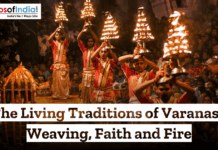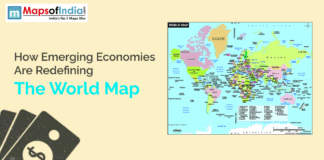With the rise of social media and the increasing use of the internet. People around the world are connected easily. The world feels smaller today. Global ideas flow freely around the world. The world has become a small village. But at the same time, local traditions hold strong. People want to understand global trends, but at the same time, not to let go of their local culture. This blend of global and local is now known as glocalisation. Shaping culture in this digital age. From food to fashion, global influences have merged with regional roots. Social media and travel fuel this shift. Yet it sparks debates about identity and authenticity.
Defining Glocalization
To define Glocalisation, it has a blend of global trends with local customs. This is not a new thing. The term first emerged in the 1980s from Japanese business strategies. This is the same as companies tailoring global products according to local tastes. A great example of it is McDonald’s, which serves McAloo Tikki in India and avoids beef products. In recent times, glocalisation is more than commerce. This has shaped art, language, and lifestyles. According to a Harvard Business Review report, which defines it as a cultural adaptation. Global platforms like Netflix stream local stories on a global level. Local artisans are now selling their crafts on global e-commerce sites. This fusion has created a hybrid identity. This glocalisation celebrates diversity while embracing shared global trends. Glocalisation is a two-way street. It’s about balance, not dominance.
The Role of Technology and Social Media
Technology plays an important role in driving glocalisation. Social media platforms like X and Instagram connect cultures across the globe. According to a recent study, there are 4.9 billion social media users worldwide. Indian creators share Holi videos with global audiences. Attracting global tourists to embrace Indian culture. Korean pop culture trends in rural India via social media. Streaming services have amplified this. Regional series have become a global sensation like Money Heist or Squid Game, finding their respective audience. Algorithms promote local content globally. A recent trend on social media showed a Marathi song “Shakey” becoming a global social media sensation, where everyone dances to it. Apps like ShareChat focus on regional languages. They bridge local voices to global viewers. Technology makes culture fluid.
Food as a Cultural Melting Pot
Food is also one of the reasons for glocalisation. Global food chains adapt to local palates. There are many examples of this, like Starbucks offering matcha lattes in Japan. Domino’s serves paneer pizza in India. According to a recent Food & Wine report, it has been noted that fusion cuisines are on the rise. Indian-Chinese dishes like Manchurian are being sold on every street of India. Sushi burritos blend Japanese and Mexican flavours. Street vendors in Mumbai are selling quinoa dosas. These hybrids reflect global diets meeting local tastes. It has also increased food tourism. Tourists are visiting a specific location to eat specific food only, like Naples in Italy, for pizza. Home cooks share recipes of their regional speciality on YouTube. BBC’s Good Food article talks about global cook-offs. In which Chefs around the world compete with glocal dishes. Food has united cultures. It tells stories of migration and innovation.
Fashion’s Global-Local Fusion
Fashion is one of the things that has the most global impact. Fashion reflects the cultural shift. Global brands design clothes as per local aesthetics. For example, Zara’s collaboration with Indian designers for an Anarkali-inspired line. According to a recent Vogue India report, which notes khadi’s rise in the global market. Local businessmen in Gujarat sell handwoven sarees on e-commerce platforms for global consumers. Fast fashion meets slow craftsmanship. In Nigeria, Ankara prints mix with Western silhouettes. Social media fuels these trends. A recent post showed a Maasai-inspired gown at Paris Fashion Week. Young, upcoming designers are blending heritage with modernity. People are now wearing sneakers with sarees. This fusion preserves tradition while being modern. It also appeals to global markets.
Music and Entertainment Cross Borders
Music and film have made the world a small village with global and local sounds. Hollywood cinema is popular globally. K-pop has established a global dominance that inspires the formation of many new pop bands worldwide. Anime has become a global phenomenon. People on Netflix are watching more anime than other content. Regional indian cinema has gained global fans. RRR (2022) winning an Oscar for natu natu has made Telugu cinema known worldwide. Streaming services have made consuming content from another country much easier. Local artists like Diljit Dosanjh are now performing on the global stage at Coachella. This is possible because of glocalisation. Streaming platforms curate glocal playlists. Entertainment has transcended borders. People globally are consuming content across the globe as per their liking. It creates shared cultural moments.
Challenges of glocalisation
Glocalisation is not always a smooth sailing ship. Mixing different cultures sparks debate. Global brands often borrow things from specific cultures without respecting them. The same thing can be seen with Prada showing Kolhapuri chappal in their recent show without acknowledging the century old Kolhapuri chappal tradition. A recent post on social media has called out a global brand for profiting off tribal designs. Missteps harm communities. Coming into a new culture without knowing its roots can be harmful. Authenticity matters. Collaboration with local artisans helps. Education prevents one from misusing one’s culture. Glocalisation thrives when respect guides creativity. Without it, cultural blending feels exploitative.
Glocalisation boosts economies. Local artisans gain global markets. But there are still some challenges that arise. Global competition threatens local industries. Socially, glocalisation is reshaping the cultural identity. Young Indians are now embracing global trends like veganism. Yet they celebrate Diwali with fervour. This hybrid identity sparks pride, but on the other hand, also creates tension. Older generations fear cultural erosion. Feelings of their culture losing its authenticity because of this trend. Balancing global and local values is key. Communities must navigate this shift thoughtfully.
Conclusion
Glocalisation is reshaping culture in this new era. Technology is now spreading ideas instantly across the globe. Food is blending global culture with local practices. Fashion is mixing local traditions with modern trends. Music and films cross borders with ease, making way for themselves. But with this positive, there are still risks that remain. Glocalisation can sometimes come with disrespect. The future promises deeper integration. The blend of global and local is a culture shift which has been amplified by technology. This shift celebrates shared humanity while it also honours unique traditions. Glocalisation isn’t just a trend. It’s a way of life that’s here to stay.





